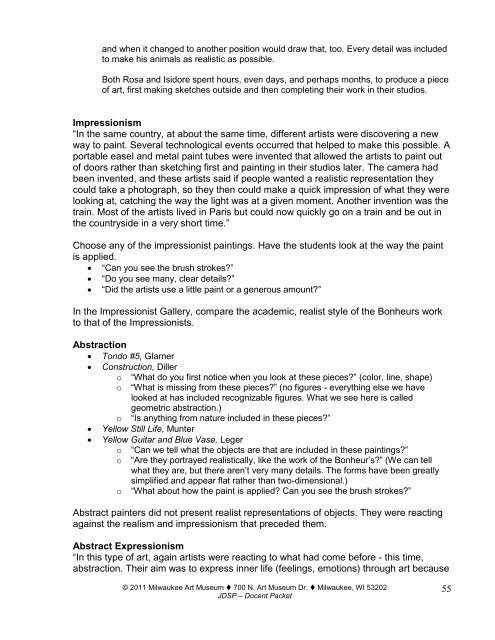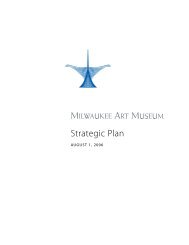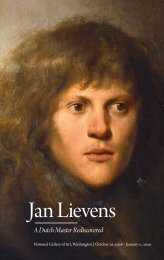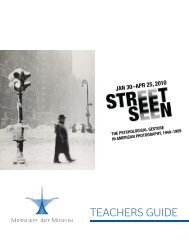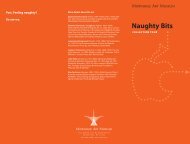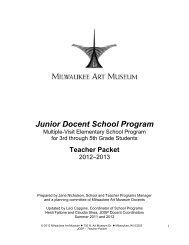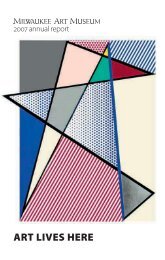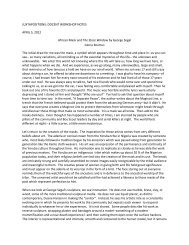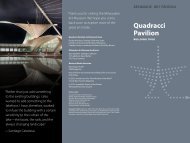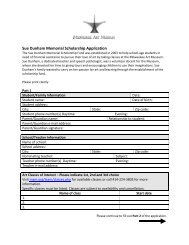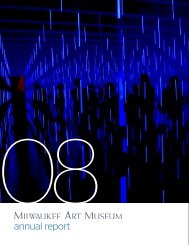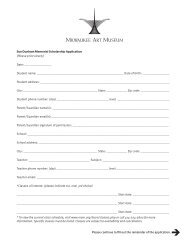Junior Docent School Program - Milwaukee Art Museum
Junior Docent School Program - Milwaukee Art Museum
Junior Docent School Program - Milwaukee Art Museum
You also want an ePaper? Increase the reach of your titles
YUMPU automatically turns print PDFs into web optimized ePapers that Google loves.
and when it changed to another position would draw that, too. Every detail was included<br />
to make his animals as realistic as possible.<br />
Both Rosa and Isidore spent hours, even days, and perhaps months, to produce a piece<br />
of art, first making sketches outside and then completing their work in their studios.<br />
Impressionism<br />
“In the same country, at about the same time, different artists were discovering a new<br />
way to paint. Several technological events occurred that helped to make this possible. A<br />
portable easel and metal paint tubes were invented that allowed the artists to paint out<br />
of doors rather than sketching first and painting in their studios later. The camera had<br />
been invented, and these artists said if people wanted a realistic representation they<br />
could take a photograph, so they then could make a quick impression of what they were<br />
looking at, catching the way the light was at a given moment. Another invention was the<br />
train. Most of the artists lived in Paris but could now quickly go on a train and be out in<br />
the countryside in a very short time.”<br />
Choose any of the impressionist paintings. Have the students look at the way the paint<br />
is applied.<br />
“Can you see the brush strokes?”<br />
“Do you see many, clear details?”<br />
“Did the artists use a little paint or a generous amount?”<br />
In the Impressionist Gallery, compare the academic, realist style of the Bonheurs work<br />
to that of the Impressionists.<br />
Abstraction<br />
Tondo #5, Glarner<br />
Construction, Diller<br />
o “What do you first notice when you look at these pieces?” (color, line, shape)<br />
o “What is missing from these pieces?” (no figures - everything else we have<br />
looked at has included recognizable figures. What we see here is called<br />
geometric abstraction.)<br />
o “Is anything from nature included in these pieces?”<br />
Yellow Still Life, Munter<br />
Yellow Guitar and Blue Vase, Leger<br />
o “Can we tell what the objects are that are included in these paintings?”<br />
o “Are they portrayed realistically, like the work of the Bonheur‟s?” (We can tell<br />
what they are, but there aren‟t very many details. The forms have been greatly<br />
simplified and appear flat rather than two-dimensional.)<br />
o “What about how the paint is applied? Can you see the brush strokes?”<br />
Abstract painters did not present realist representations of objects. They were reacting<br />
against the realism and impressionism that preceded them.<br />
Abstract Expressionism<br />
“In this type of art, again artists were reacting to what had come before - this time,<br />
abstraction. Their aim was to express inner life (feelings, emotions) through art because<br />
© 2011 <strong>Milwaukee</strong> <strong>Art</strong> <strong>Museum</strong> 700 N. <strong>Art</strong> <strong>Museum</strong> Dr. <strong>Milwaukee</strong>, WI 53202<br />
JDSP – <strong>Docent</strong> Packet<br />
55


